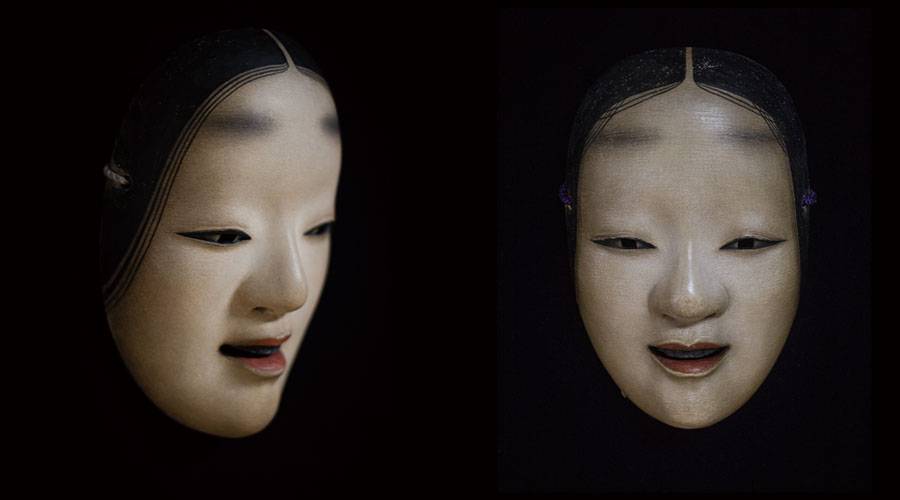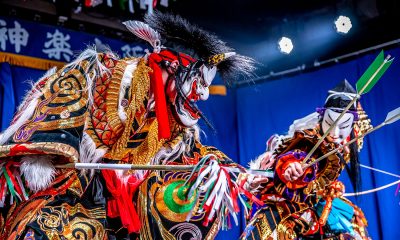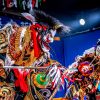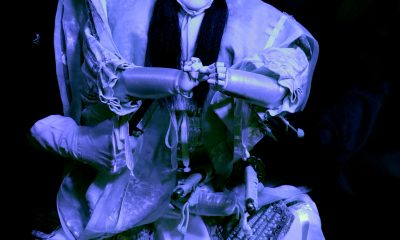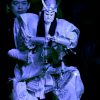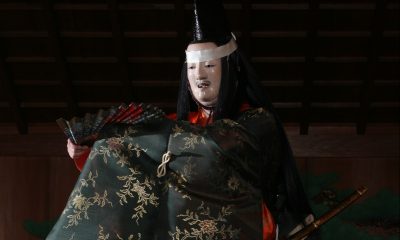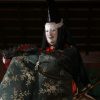Feature
The Treasures of Noh
The face behind the masks: A Kyoto woman forges an uncommon life carving faces for one of Japan’s oldest theater arts.
“Patience is a lifelong treasure” – a Japanese proverb that nō-men-shi (Noh mask maker) Mitsue Nakamura has embodied and exhibited in her life and her life’s work. Not only because her craft demands it, but because she needed patience in order to forge the unique life that she dreamed of.
Located in Higashiyama, a charming area in historic Kyoto that is now dotted with antique shops brimming with Japanese art, culture, and tradition, it is here that you find Ms. Nakamura’s home; a perfect fit for a woman who has been perfecting her craft for over 30 years.
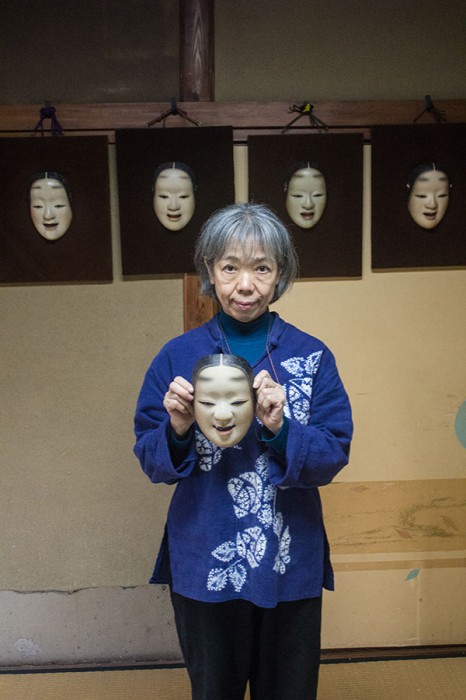
“The house is over one-hundred years old,” she says in English with a shy smile.
The cool autumn air mixes with the smell of hinoki wood from which the nō-men (noh masks) are made, adding to the presence of the traditional Japanese home, that also serves as her workshop.
Ms. Nakamura’s masks are used by some of Japan’s top Noh (Classical Japanese musical drama) performers to tell intriguing and fascinating tales. Originating in the 14th century, Noh, which comes from the Japanese word for “skill” or “talent”, is one of Japan’s oldest theater arts and is recognized by UNESCO as having “Intangible Cultural Heritage”. One of only 30 professional nō-men-shi in all of Japan, just five of which are women, this masterful creator behind these storytelling tools has her own interesting story.
Born in Mie prefecture in 1947, Ms. Nakamura’s family moved to Osaka when she was five years old. She showed a love for art from a young age and started painting portraits as she found herself drawn to human faces. She grew up in a generation of women who were generally expected to get married and raise children right after graduating high school. For those who did find work, it was customary to quit their jobs after marrying and not join the workforce again.
However, Ms. Nakamura’s parents did not place so much emphasis on her getting married, and they always encouraged her to pursue her talents. She herself didn’t want to settle down right away, so after graduating high school, she continued to study art.
In 1969 she graduated from the Kyoto City University of Fine Arts (presently, Kyoto City University of Arts) and went on to teach high-school art for two years. She said while she enjoyed teaching the students, she didn’t like the staff room politics.
“I wanted to pursue something that would allow me to work on my own, that would allow for more freedom and independence,” she said.
This dream, however, was put on hold for a while when after two years of teaching, she did decide to get married and had two children. But married life wasn’t what she had hoped it would be, and she soon realized she wanted to leave her husband. Making decisions with her children’s best interests at heart, however, she felt she had to wait until they were over 18 before divorcing.
Her dream of becoming a Noh mask craftswoman began when her kids started going to kindergarten. She had a little more free time during the day, so she decided to spend that time learning how to make Noh masks. It was 1983, she was in her mid-thirties, and this was her first step on what would be a 25-year journey to achieving her dream of earning her own salary through being a professional Noh mask maker and teacher.
In 1990, she began to study with the esteemed Hori Yasuemon, a brilliant mask maker renowned within the Noh community. After only two years under his instruction, she reached a major milestone on her path to success. One particularly well-known Noh actor, noticed and became fascinated with her knack for the art of Noh mask making, and bought the first mask she ever sold.
“I was so shocked, I didn’t know how to respond when he asked me the price,” she said with a laugh. Later, her reputation reached the attention of the head of the Kanze school (one of the five major schools of Noh), Kiyokazu Kanze.
“I’ll never forget how I felt when he offered to buy my mask. I still cannot express how surprised, moved, and joyful I felt.”
Kanze has bought four masks from her over time, four of more than 200 masks she has sold throughout her career.
Each Noh mask is carved from a single piece of hinoki and takes several weeks to a month to complete. Many become heirlooms and are considered a sacred entity, so it is little surprise they can sell upwards of ¥500,000.
It is the actor’s job to infuse the mask and bring the emotions to the audience with subtle movements of the head. Terasu (tilting upwards) generally gives a lighter feeling of laughter or smiling; kumorasu (tilting downwards) gives a range of sadder expressions, such as frowning or crying.
By using small, controlled movements, a professional Noh actor can have a full range of emotions from one mask.
It is the job of the mask maker to instill a variety of emotions into the mask while also ensuring it remains in a state of neutrality.
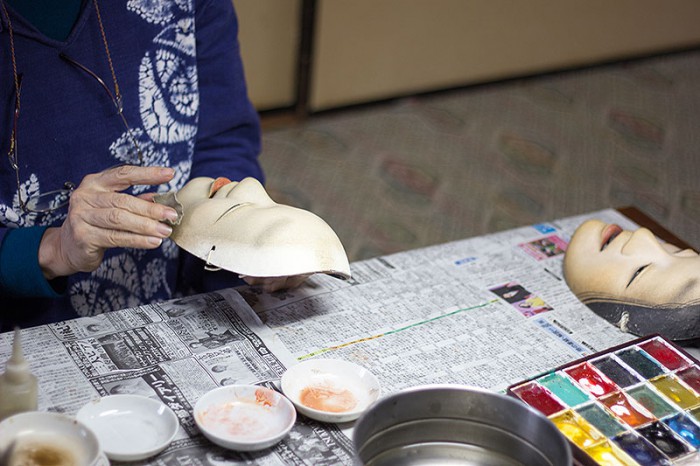
Ms. Nakamura says she always has in mind which mask she will create before she begins, but sometimes the wood has its own ideas, and a different character takes over during the carving process. To create vessels of such strong yet subtle expression, a mask maker must put their heart and soul into carving out these characters.
“When creating a mask of a beautiful girl or child I feel very happy but when creating an onryo (vengeful spirit or ghost) I can feel sorrow or anger,” she said.
It may be no coincidence that Ms. Nakamura wields a chisel so naturally and with such skill. One of the main chisels used for carving Noh masks is called a tou, which is another word meaning samurai sword. Ms. Nakamura always credited her parents for encouraging her to learn a skill that could allow her to support herself without a husband, and this modern thinking could be attributed to her family being of samurai lineage. After the reforms of the Meiji Restoration (1868-1912) that saw the ushering in of modern Japan, her ancestors learned the importance of being self-sufficient, independent, and having a diverse range of skills – values which were passed down to her.
Samurai believed their souls dwelled in their swords which is why they treasured them. Ms. Nakamura’s masks embody many souls when worn on the stage, and her creations are absolute treasures.
Things you should know about Noh
Originally there were around 60 types of Noh masks but today there over 200.
The waka-onna (young woman), is perhaps the most well-known and depicts the standard of classical beauty for medieval Japan. The classic Noh mask, the onnamen (woman mask), has many variations that at first glance might go unnoticed, even when looking at them side-by-side.
The hannya mask with horns represents a distressed demon often used during the transformation of a female character when she reveals her jealousy, anger, or sorrow.
Noh masks exaggerate features such as the contours of the mouth and eyes. This leaves the mask with a neutral expression that can take on many different forms when viewed from different angles.
When the actor goes to the kagami no ma (mirror room) to put on the mask, they use the word kakeru (to hang), or tsukeru (to attach), instead of kaburu (putting on clothing), to symbolize that the actor is transforming into that character.
Mitsue Nakamura holds mask making classes in Kyoto, Osaka, and Tokyo. Tel: 080-5355-2559
mitsue-yuya.com
能の至宝
能面制作に打ち込む名工を京都東山に訪ねる。
堪忍は、人生の宝。能面師の中村光江さん が、人生と仕事の指標に掲げている諺だ。 根気のいる工芸はもちろん、自分が望んだ 人生を全うするためにも堪忍が必要なの だ。日本社会の様々な壁が立ちはだかった ときはいつも堪忍で人生を切り開いてき た。さもなければ現在のように優れた能面 師となることも叶わなかったかもしれない。 中村光江さんが制作する能面は、日本最高 レベルの能楽師達にも愛用されている。伝 統芸能を支える名人芸の裏には、能の夢幻 の物語と同様に、人の心を惹きつけてやま ない彼女自身の物語があった。
1947年、中村さんは、三重県に生まれ た。5歳の時に家族で大阪に引っ越し、そ の後の青春時代を大阪で過ごした。幼い ころから、美術に関心があったが、特に人 の表情に惹かれたと振り返る。高校卒業 後は、同級生たちはそれぞれの進路を見 つけて歩みだしたが、中村さんは、京都市 立美術大学(現・京都市立芸術大学)に進 学、1969年に卒業の後は、高校で美術を 教えた。教壇に立つことは楽しかったが、他 の教師との付き合いや教職員室でのしき たりは面白くなかったと彼女は言う。2年間 の教師生活に別れを告げ、結婚。2人の子 供にも恵まれたが、夫との間にすこしずつ すれ違いが起こりだしていた。それでも中 村さんは子供たちの気持ちを第一に考え て彼らが成長するのを待ち、結果的には離 婚までは時間がかかった。だが、その間、子 供たちが幼稚園に通いだすとその日中の わずかな自由時間で能面制作を学び始め る。1983年のことである。当時30代半ば の中村さんは、その後四半世紀にわたる自 立への道のりを歩みだしたのだ。
1990年、中村さんは、能面の名工として知 られる堀安右衛門氏に師事する。それから わずか2年後、成功への足掛かりとなる最 初のチャンスがやってきた。ひとりの能楽師 が彼女の打つ能面に魅せられ、買い取って いったのだ。「もう驚きました。値段を聞か れて、どう答えていいやらわかりませんでし た」と本人は振り返る。そののち、能面の評 判が人伝てに五大流派のひとつである観 世流の宗家の観世清和氏の耳に届いた。「 宗家が私の打った面を買い上げたいとおっ しゃた瞬間の驚き、感動、身に余るような光 栄、どう表現したらよいものか」と、今でも 中村さんは、戸惑いと、喜びを見せる。観世 氏はこれまで彼女が制作した4点もの面を 買い上げている。結局これまでに200点以 上に及ぶ能面が能楽師やその他の愛好家 の手に渡っていった。
生まれつき内省的で、人一倍自立心が強い 芸術家肌。それでいて明るく人間味に溢れ た中村さんは、今や自分の作品を通して世 界に力強く語りかけるまでの名工に成長し た。日本にはプロの能面師が30人いるが、 女流作家は中村さんを含めて5人のみ。男 性中心の能の世界で、女性が能を演じる機 会は伝統的に少ない。しかし中村さん自身 は女性であることで能の世界で差別を受 けた経験はないと言う。
夫から自立するため、能面制作の技術を身 につける。こんな考えもおそらく一族の伝 統なのだろう。中村さんの実家は藤堂藩に 仕えた士族の家系である。明治維新後は、 生き延びるために自立して多彩な技能を 持つことの大切さを学んできた。中村さん にもきっとこの資質が受け継がれているの だ。刀を崇め、我が身とし命を懸け生きた 武士の先祖を持つ彼女は、日々、刀(とう) と呼ばれる彫刻刀を手に命を込め、能面を 打ち続けている。彼女と能面との出会い は、決して偶然のなせる業ではなく、彼女 の中に流れるサムライの血が能面を引き寄 せたのではないだろうか。
今、彼女は京都東山区に居を構え制作に打 ち込んでいる。周囲は骨董品店が多く、日 本美術や伝統文化が満ち溢れる魅力的な エリアだ。築100年を超える中村さんの自 宅兼工房は、日本最古の舞台芸術を支える 仕事場にぴったりの伝統的な日本家屋であ る。玄関を入り、きしむ階段を上がって工房 に入ると壁一面にかけられた様々な能面が 圧巻である。ひとつひとつの面が様々な表 情を持ち、語りかけてくる。哲学的でもある これらの面を用いて演じられる能楽は、14 世紀に完成したといわれ、ユネスコ世界文 化遺産に指定された日本最古の舞台芸術 のひとつだ。そして能面は、1点ごとにヒノ キから打ち出され、完成までにひと月はゆ うにかかる。多くの能面は家宝として扱わ れる神聖な存在でもあるため、1点50万円 以上というのも無理からぬ話だ。
いつもは頭の中であらかじめイメージを決 めて打ち始めるという中村さんだが、時に は、木が勝手にアイデアを主張し始め、そ のうちすっかり違う表情が浮かび上がると いうことも起こるそうだ。そのように印象 深く繊細な表情を生み出すため、能面師 は木から夢幻の表情を打ち出すことに心 血を注ぐ。
「美しい乙女や純粋な子供の面を打ってい るときはとても明るい気持ちになりますが、 鬼の面を打つ時には悲しみや怒りを感じる 時があります。」
中村光江さんの堪忍は、本物の美徳であ ると断言できる。その豊潤な人生経験から は、究極の至宝が生み出されるのだ。
中村光江さんは、京都、大阪、東京で、能面 教室を開講しています。
電話:080-5355-2559
mitsue-yuya.com


